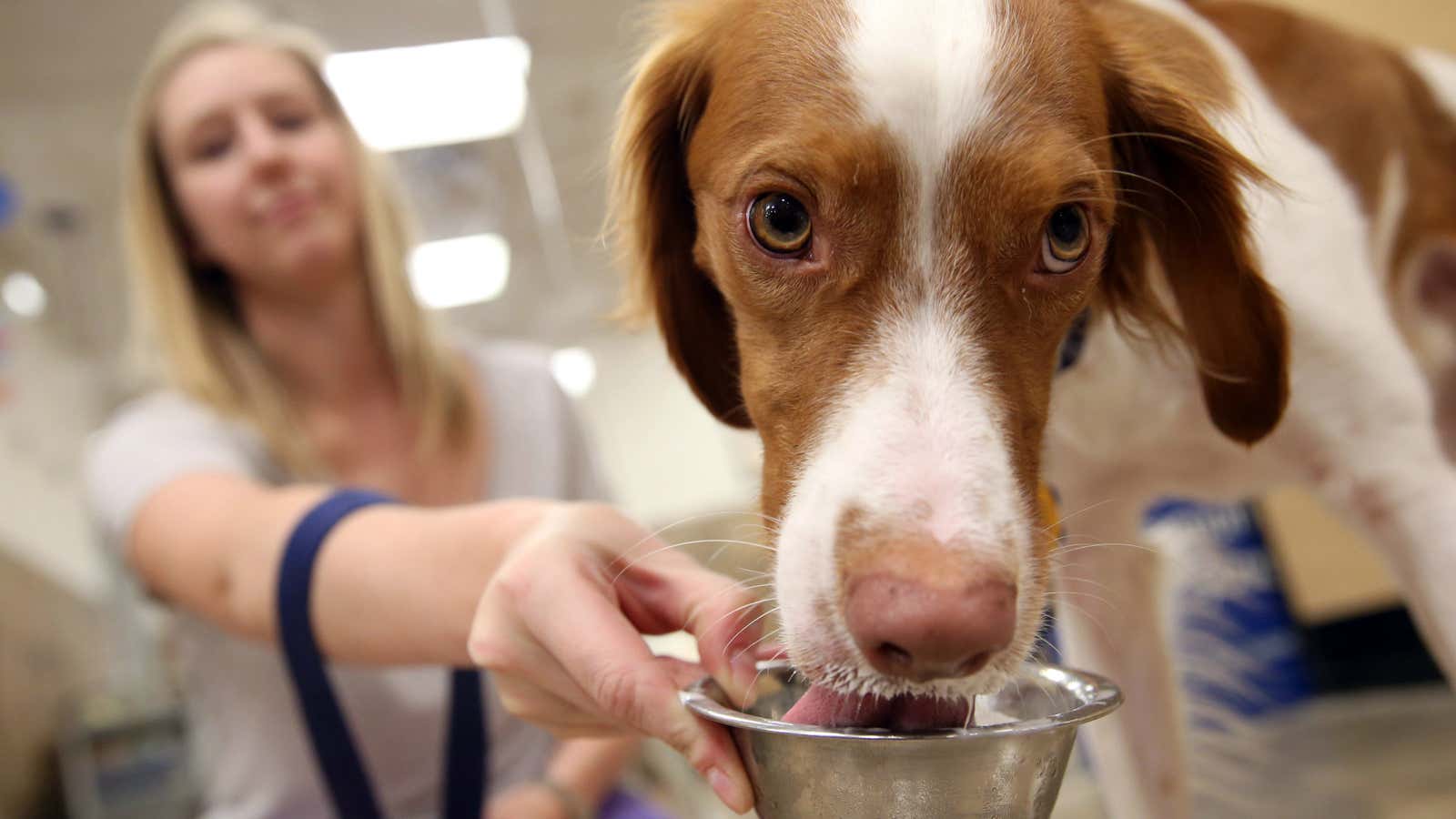Anyone who says “love don’t cost a thing” probably doesn’t own a pet.
Americans spent more than $22 billion on food for their beloved domestic animals (and tens of billions more on supplies, vet care and other services) in 2014. And those looking for words like “natural,” “gluten-free,” and “organic” on the labels spent the most.
At pet-focused retailers in July 2015, the average price per pound of pet food was $2.28, according to the market research firm GfK. But for “natural” pet food, that jumps to $2.64. Organic pet food was up at $3.66 a pound, and “raw” food beat them all at $12.08 per pound.
But in most cases, those pricy products for dogs and cats aren’t any better than the cheaper stuff. Here’s why.
The words used to tout fancy pet food are largely meaningless—and unregulated
Many of the words used to describe pet food don’t even have official definitions. “Human-grade,” for example, does not. Neither does “gluten-free.”
There are two levels of regulation for pet food in the US. The first is through the Food and Drug Administration (FDA), which establishes certain standards applicable to all pet foods, like proper listings of ingredients and identification of the product.
The second is at the state-level: Most states have their own pet food labeling rules, largely based on guidelines from the Association of American Feed Control Officials (AAFCO). These are more specific and include feeding instructions, nutritional adequacy statements, and some claim definitions. But AAFCO itself does not have any regulatory or enforcement power and its definitions are hardly stringent.
The ubiquitous “natural” claim is a case-in-point: ”Natural” actually means more when it comes to pet food than it does for human food (where there is no definition at all), but that isn’t saying much. Here’s AAFCO’s definition:
A feed or ingredient derived solely from plant, animal or mined sources, either in its unprocessed state or having been subject to physical processing, heat processing, rendering, purification, extraction, hydrolysis, enzymolysis or fermentation, but not having been produced by or subject to a chemically synthetic process and not containing any additives or processing aids that are chemically synthetic except in amounts as may occur unavoidably in good manufacturing practices.
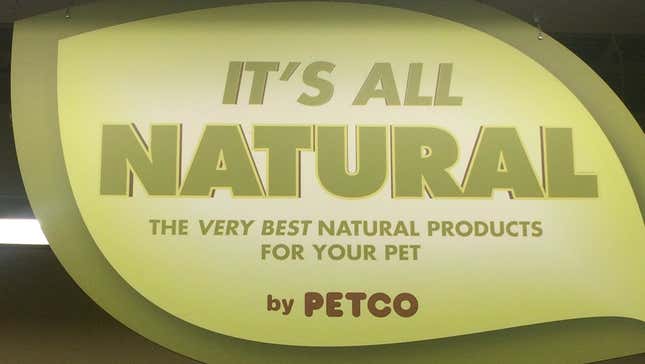
In other words, as the editor-in-chief of the trade publication Petfood Industry wrote: “When it comes to using a natural label claim on a pet food, just about anything goes.”
Organic pet food is also regulated by the US Department of Agriculture (USDA) which is in charge of the National Organic Program. Pet food-specific standards for the term “organic” are currently being drafted but for now, organic pet foods must meet the same criteria as organic human foods. For some people, that may be reason enough to buy it, but keep in mind: The organic seal won’t necessarily make it safer, more nutritious, or better for the environment.
There’s no reason to fear the by-products and meals in most pet food
A by-product is simply a part of the animal that the typical American consumer doesn’t want to eat, like pig liver or chicken feet—and many of these are relished by humans in other parts of the world. A meal is the result of rendering, a process where parts are heated, strained, and ground up.
“There’s really nothing wrong with feeding those kinds of products to animals,” Dr. Cailin Heinze, a board-certified veterinary nutritionist at Tufts University told Quartz in June. “Organ meats actually have much more nutrients in them than muscle meats.”
While people are understandably concerned about the use of antibiotics and synthetic growth promotants in raising conventional livestock for public health and animal welfare reasons, it’s very unlikely that those substances will get passed along to your pet through their food, largely because the rendering process cooks the food at very high temperatures. Any trace amounts of these substances that are left in the carcass (which should already be minimal because of required withdrawal periods) will likely be eliminated by the process.
Meat that tests positive for E. coli can also end up in pet food since the rendering process, and then a second heat treatment at the pet food company, will kill any dangerous bacteria. ”Heat deactivates pretty much everything and rendering is done at a very high heat,” Jessica Meisinger of the National Renderers Association told Quartz.
Using by-products is a smart way to recycle and reduce waste
The “nose to tail” movement argues that human carnivores in the West should get over their distaste for offal and off-cuts, and eat the whole animal, to make the meat industry more sustainable and less wasteful. For pets unencumbered by these cultural aversions, it’s a no-brainer.
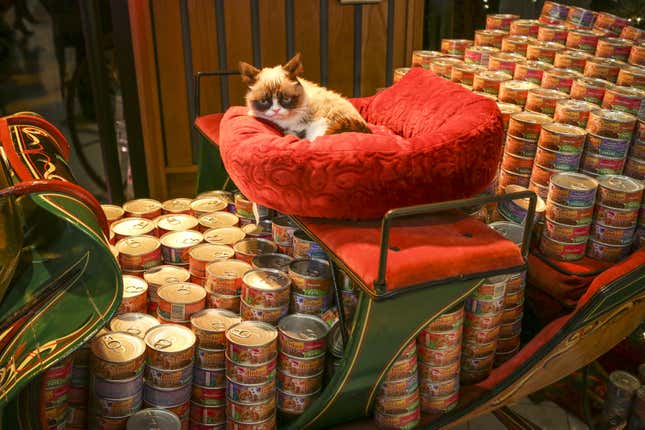
Turning meat industry by-products into pet food is basic recycling: it reclaims waste as usable material. Packing plants process nearly 10 billion chickens and turkeys and 150 million heads of cattle, calves, hogs and sheep each year in the US, according to the National Renderers Association. Nearly half of the weight of those animals is considered inedible by American consumers but can be used in pet food, instead of being tossed in a giant, toxic pile of trash.
The same is true of the nearly 2 billion pounds of grocery store waste, including scraps and expired meat, and the animals that die on farms before they are slaughtered.
“The whole rendering business is one of the biggest recycling businesses out there,” says Frank Mitloehner, professor and air quality extension specialist at the University of California Davis’ Department of Animal Science. Without rendering plants, he says, there would be huge biosafety and biosecurity issues because it’s the only way to dispose of livestock. “Not to use [the rendered protein] for a purpose like pet food would really be very wasteful,” he says, and it would add to the 30-40% of food nutrients that go uneaten in the US each year.
Rendering also emits fewer greenhouse gases than allowing these animal carcasses to decompose naturally would. A 2012 study published in the Journal of Industrial Ecology (and funded by the Fats and Protein Research Foundation, which supports the rendering industry) found that rendering emits about a third of the carbon dioxide that would be released if the raw materials decomposed on their own.
A smaller, more specialized operation doesn’t necessarily have better quality control
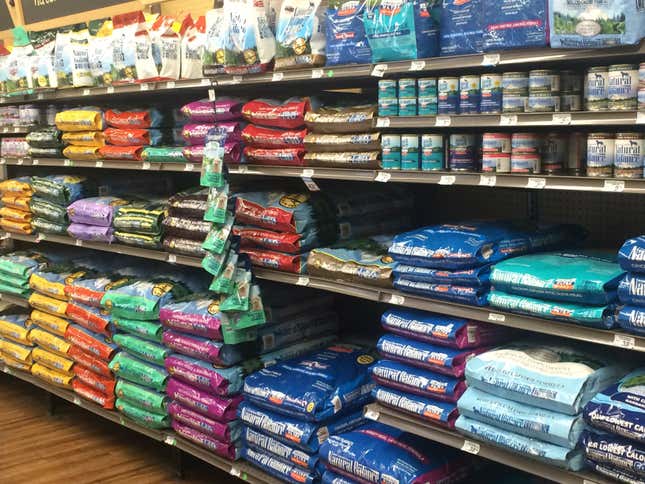
Pet food is only as good as the ingredients in it—and the smaller, high-end companies are no more transparent about their supply chains than the giant corporations are. Sometimes they’re more opaque.
For example, Nestlé Purina Petcare Co. sued the “natural” pet food company Blue Buffalo earlier this year, and revealed that its claims that its food had “NO Chicken/Poultry By-Product Meals” were false. Blue Buffalo laid the blame upon its ingredient supplier, Wilbur-Ellis, which ultimately took responsibility and corrective measures (and added that safety was never an issue). But the incident showed that Blue Buffalo wasn’t monitoring its suppliers as closely as customers may have expected. Blue Buffalo did not respond to requests for comment.
Orijen, another small pet food company that boasts of its superior quality products—with the motto “Nourish as nature intended”—declined to provide Quartz with information about the regularity of the audits or what the results were. It would only say that its “audits are conducted on different schedules depending on the supplier.”
Of course, Nestlé’s suppliers aren’t perfect either—only 73% of the ones the corporation audited were fully compliant in 2014—but the company is at least transparent about the steps it takes to make sure that what it says is in its food is what’s actually in there.
There are no safety silver bullets—more expensive foods get recalled, too
Even though most pet food is safe, the specter of contamination always looms, thanks in large part to a huge 2007 pet food recall traced back to tainted ingredients from China, which sickened and killed an unknown number of cats and dogs, and sent pet owners across the country into a panic. But paying extra for a fancy label will not help your pets avoid this danger.
Although large companies have had problems in the past, a review of the current recalls shows that a number of relatively small companies have also had to alert customers about safety issues.
And the food most likely to have a disease-causing bacteria, according to the FDA, is also the most expensive: raw pet food. As Fortune reported, the growing raw pet food industry has been accompanied by an increase in raw pet food recalls, and an FDA study found significantly higher levels of salmonella and E. coli in raw pet food samples than the rest. The American Animal Hospital Association, American Veterinary Medical Association, and the Centers for Disease Control all discourage owners from feeding pets raw food diets, all noting that bringing these foods into your home means you could be exposing yourself and your family members to pathogens as well.

A lot of this boils down to inadequate regulation. Even as consumers want better pet food, the industry resists calls for more required testing pointing to improvements it has made on its own. In the US, a new rule under the Food Safety Modernization Act, which would make companies responsible for the integrity and sanitation of pet food manufacturing supply chains, is due by the end of 2015, but there are doubts about whether it will be adequately enforced, as the Huffington Post detailed earlier this month.
For now, though, keep your money. Pricier brands are not offering better protection.
Your pet doesn’t need to eat just like you do
We tend to want to give our animals food that mimics what we eat—and reflects our own beliefs and prejudices about what’s healthy, ethical, and delicious. But just as people don’t (usually) eat pet food, pets don’t need to adhere to our diet.
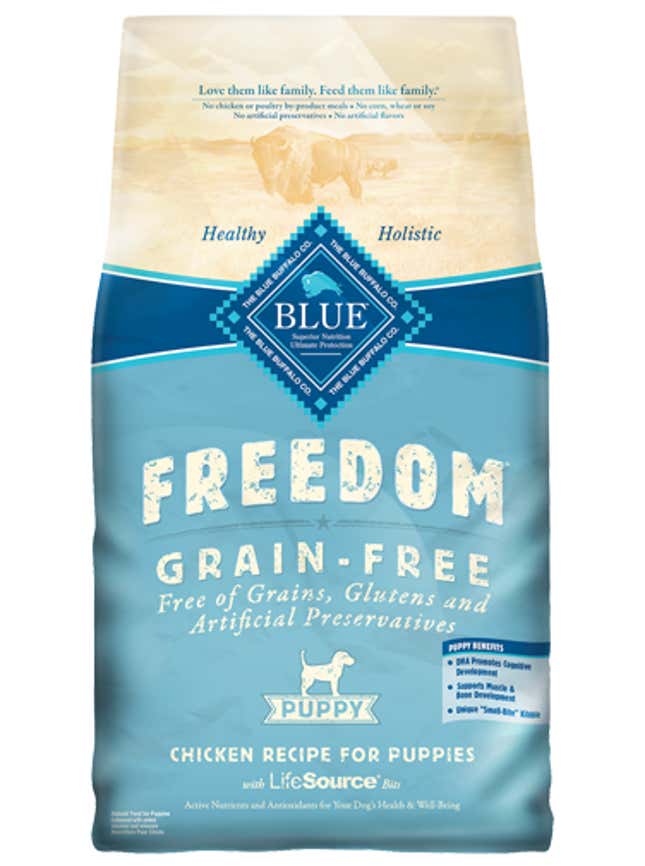
Gluten-free pet food brings in about $700 million annually in the US, according to GfK, but there’s no health-related reason for the trend. “Gluten intolerance as it’s recognized in people is not recognized in companion animals,” Dr. Kathryn Michel, Professor of Nutrition at University of Pennsylvania Veterinary School told Quartz in May. “It doesn’t exist.” While some pets may have specific food allergies, as Kurt Gallagher of the industry group Pet Food Institute, told Quartz, “food allergies in pets are far less common than allergies to flea bites and environmental allergens.” And even within the food allergy family, he says, “meat is more likely to be an allergen than grains.”
The bottom line: Don’t trust a label, and do your own homework
Of course, some pets do require special diets based on their medical conditions. Let your veterinarian recommend those, instead of relying on the claims printed on a pricey bag of kibble.
And if you really want to spoil your pooch, grab a ball and go to the park. It’s good exercise for you both—and it’s free.
